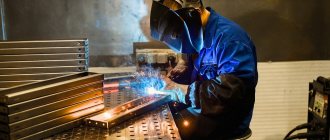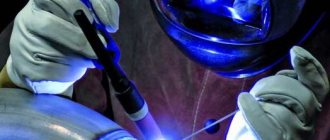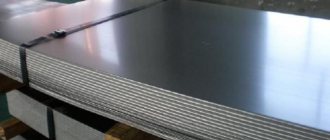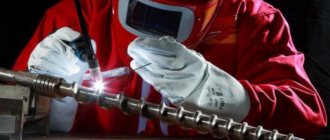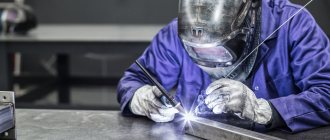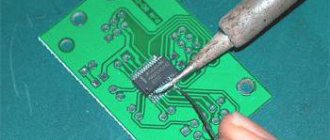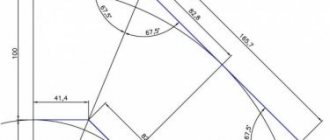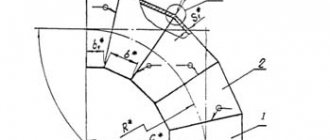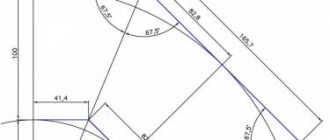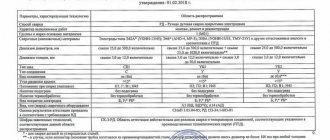Welding of metals by fusion is carried out in various ways, which have one thing in common - the use of an electric arc (excluding gas welding). One of the most popular is MIG welding in semi-automatic mode. It is accessible even to a novice welder, and professionals can weld almost any metal of varying thickness and complexity of the configuration of joining parts.
In its technical essence, it is fusion welding in a protective gas atmosphere, which excludes chemical reactions in the melt (GMAW - Gas metal Arc welding). The MIG welding machine operates in an environment of argon, helium or other inert gases. Various grades of steel, aluminum, magnesium, titanium, and nickel alloys are welded using this method. The common name is metal inert gas welding (MIG).
MIG/MAG welding technology
MIG/MAG welding is carried out in semi-automatic mode. The automatic welding machine operates in an atmosphere of inert or active gaseous substances. During welding, an arc lights up between the workpiece and the welding wire (electrode). Under the influence of the heat of the arc, the material being welded is completely melted. As a result of this process, a weld pool is formed. It is protected from oxygen by a gaseous substance supplied by the burner nozzle. Over time, the elements in the weld pool begin to crystallize, forming a weld.
It is necessary to select a shielding gas in accordance with the material of the part being welded and its thickness. When welding non-ferrous metals in a semi-automatic mode, mixtures of argon or helium are used. When welding cobalt or copper materials, nitrogen is used. When welding steels, carbon oxides are used. To improve the strength of the ignited arc and accelerate the formation of the weld, mixtures of MIG and MAG gases are often used.
The following types of MIG/MAG welding are distinguished:
- Large droplet: carried out without short circuits.
- Fine: During welding, small particles of metal are separated from the metal. This type of welding is carried out without short circuits.
- Without short circuits: produced during welding of materials at low voltage welding current.
In semi-automatic drop transfer welding, the welding current density increases, which leads to an increase in arc voltage. As a result, the character of the electrode changes. Large particles are separated from the welded product. The disadvantage of this type of welding is high spatter rates. For this reason, the quality of welding of parts in the ceiling position decreases.
Welding with small droplet transfer is carried out at high voltages and high density welding current. With it, the welded material in a molten state flows into the weld pool. Therefore, this welding method is also called jet welding. When welding products with small droplet transfer, the intensity of heat transfer increases, which leads to a change in the shape of the weld. The main difference between this method of semi-automatic welding is the stability of the burning arc. This means that the welding current voltage does not change.
When welding parts without causing short circuits, the metal in the molten state is transformed into a drop, which leads to an increase in the voltage and length of the burning arc to maximum values. The intensity of the current supply remains unchanged, so the material in the molten state moves into the weld pool until a short circuit occurs.
In addition to semi-automatic MIG/MAG welding, there are 2 other types of welding: MMA and TIG. The decoding of these abbreviations means “manualmetalarc” and “TungstenInertGas”. The main difference between MIG/MAG welding and MMA and TIG welding is the high potential when supplying electrodes and gaseous substances. This increases the welder's work efficiency. Unlike MIG/MAG technology, TIG or MMA welding does not require a large number of machines and tools, because the welding process is different in manual mode.
Unlike other metal welding technologies, MIG/MAG welding has the following features:
- Small time costs for changing welding wires.
- The welding process is fully automated.
- Metals can be welded in any spatial position.
The main disadvantage of this technology is the large losses due to the spattering of molten material, which is associated with the powerful radiation of the burning arc and restrictions on the supply of welding current. When MIG/MAG welding of products, it is also necessary to purchase special welding machines (semi-automatic) that act as a source of electricity and a gas distribution mechanism.
Seam formation
In MIG/MAG welding, a weld is formed by melting the electrode wire. As a result of this process, the basic welding materials crystallize. The resulting seam is reliably protected from exposure to atmospheric air by a gas film. Its size and shape depend on the characteristics of the transfer of material into the weld pool. As heat transfer increases, a small depression is formed in the weld pool, which affects the weld formation procedure.
Operating principle of semi-automatic welding machine
The principle of operation of a semi-automatic device is, first of all, that the wire electrode itself, which during manual arc welding a specialist feeds independently with the help of a hand and a holder, in a semi-automatic device is fed using a motor. Therefore, this method is called semi-automatic MIG welding. The wire performs a dual function - it is both a conductive electrode and a filler material. An electric current is applied shortly before the electrode exits the torch, causing an arcing phenomenon to occur between the end of the wire electrode and the metal.
Shielding gas is supplied through a gas nozzle surrounding the wire electrode. Due to its inertness, the burning gas displaces all atmospheric gases, preserving the strength of the structure of the welded seam. However, in addition to the protective function, gas also performs peripheral tasks. The composition of the atmosphere in the electric arc zone depends on the protective gas, which also has a positive effect on its electrical conductivity.
Advantages and disadvantages
The following advantages of welding in semi-automatic mode are highlighted:
- Allows the use of high voltage welding current.
- High quality welds.
- Allows you to weld products with a wide range of thicknesses.
- Allows the process of seam formation.
- Does not require the use of slag or flux.
- Allows you to create tight connections of galvanized products without damaging the coating of the parts being welded.
- Provides the ability to weld thin steel or aluminum sheets up to 0.5 mm thick.
- Base materials are not exposed to dirt or corrosion during welding.
The main disadvantages of MIG/MAG technology are:
- Requires the purchase of expensive semi-automatic devices.
- High complexity of technology.
- It is impossible to weld parts in hard-to-reach places, which is due to the large difference in the sizes of the torch and electric holder.
- Mandatory preparation and cleaning of the edges of the parts to be welded.
- The ignited arc emits a large amount of light energy, which leads to an increase in radiation. For this reason, the welder is required to use protective face masks while working.
- Strong splashing of metal in a molten state.
Compared to TIG technology, MIG/MAG welding is used in industrial sectors. This is due to the complete mechanization of the welding process, which reduces production costs in the long term.
Problems when welding galvanized metal
The advent of the MIG soldering method made it possible to avoid such problems. The MIG soldering method differs from the MIG welding method only in the type of wire used and the process mode.
For MIG soldering, CuSi3 copper wire is used. Its solidus temperature is low, which avoids melting of the base metal. The zinc coating does not evaporate, but when it gets into the bath, it forms a chemical compound on the surface close to brass, which protects the welding seam from corrosion.
Application area
MIG/MAG technology is used for:
- Welding plates with a thickness of no more than 0.5 mm. When working with these materials, it is necessary to increase the heat supply intensity. This will avoid plate deformation and increase productivity.
- Welding low-alloy materials with low carbon content.
- Welding products made of iron or aluminum alloys in all spatial positions
- Welding plates made of non-ferrous metals of medium size (up to 0.2 cm).
Due to the fact that the MIG/MAG method allows welding dissimilar metals of all classes, it is actively used in many industries. This technology has found application in the production of automobiles, marine vessels and offshore structures. The use of semi-automatic welding in production requires a lot of professional skills and abilities from the welder. The worker must be able to operate welding machines consisting of a large number of substructures. When organizing industrial production using MIG/MAG welding, you need to carefully prepare the work shops: set up ventilation and purchase stationary welding devices. Otherwise, the gas system will operate unstably due to exposure to drafts.
Welding mode for galvanized steels
Soldering is carried out in a protective environment of inert gas, and the result is achieved through the selection of the optimal mode of the main and pulse current, while the transition of the additive to the seam occurs without a short circuit. In pulse current mode, its fluctuations from minimum to peak values are 0.25 to 25 Hz. Several times less heat is released onto the product, and the spread of thermal influence in the volume of a solid body is sharply limited. The drop is torn off from the filler wire by impulse - as a result, the entire process is practically free of spatter. In addition to galvanized steels, the process is used for carbon, low-alloy and corrosion-resistant steels. Welding and soldering can be used to make vertical seams in any direction (from ceiling to floor and vice versa - no problem) and ceiling seams. Speed – up to 1000 mm/min. MIG brazing is used to connect very thin steel sheets with minimal deformation. The MiG soldering method is used in car repair shops, shipbuilding, and in ventilation and air conditioning systems. Another option is that bicycle frames are perfectly connected using this method.
Types of equipment for MIG/MAG welding
To weld parts using MIG/MAG technology, power sources are required. Their role is played by rectifiers and inverters. They allow you to increase the amplitude of high-frequency voltage. There are 3 categories of inverters for welding:
- Household: most often used by novice welders for one-time projects. They can weld small parts. The welding current of household rectifiers is no more than 200 A.
- Professional: Used by welders working in small commercial settings. They can weld large parts without losing quality. The welding current of professional inverters is 300 A.
- Industrial: used in large industrial organizations. They are capable of continuously welding large structures while maintaining basic weld size and shape requirements. The welding current of industrial rectifiers is no more than 500 A.
Inverters ensure stability of the welding current and reduce the range of spatter of the molten electrode. The versatility of this device allows it to work with stainless steel and aluminum. Rectifiers consume a small amount of electricity. They are small in size, which improves comfort during welding work.
In domestic conditions, an inverter semiautomatic device with a Euro connector is most often used, allowing you to quickly connect the burner. Rectifiers allow welding in 2 modes, both in an inert gas atmosphere and using fleece. For frequent use, it is recommended to buy universal welding machines that can work using different welding technologies. Their main disadvantage is their high cost.
Selecting a device
When purchasing a welding machine, you must consider the following indicators:
- Power type: It is recommended to purchase devices that operate on direct current. When activated in reverse polarity, these devices provide better performance. Devices operating with alternating current and straight polarity are not able to maintain a stable voltage on the arc, which leads to increased metal spattering and a change in the shape of the weld.
- Mains voltage: single-phase or three-phase. Universal welding machines operate at a voltage of 220 V. It is important that the devices are protected from power surges. Otherwise, they will not be able to work in networks with different power supplies.
- Temperature limits: Most welding machines operate at temperatures between -40°C and +40°C. At higher values of this indicator, devices are automatically turned off.
- Availability of additional options: modern machines are capable of performing MMA and TIG welding. By combining many functions, they can be used to solve a large number of problems. Also, modern models have support for HotStart, AntiStick and ArcForce options.
The main technical characteristics of the welding machine are indicated in the device passport. It is important that the device is made of durable materials and has a long warranty period.
Selecting consumables
The main consumable material required for welding is welding wire. Its diameter must correspond to the thickness of the material being welded. Also, the part and the wire must be made of identical materials.
When welding, it is necessary to select the correct shielding gas. When processing parts made of non-ferrous metals, it is better to use inert gaseous substances (helium, argon and their mixtures). When working with iron alloys, it is recommended to use carbon monoxide. It is important that in this case the welding wire contains an increased amount of silicon and manganese. Experienced specialists recommend using mixtures of active and inert gases that reduce the range of metal splashing.
Equipment and components
So, for work we need a standard semi-automatic machine. A set of welding equipment consists of a semi-automatic machine, a transformer (generating current), gas (a reducer must be attached to the cylinder to regulate the pressure), various hoses and cables, a gas torch equipped with an additional filler wire supply system and a feed mechanism.
MIG welding is essentially the same as gas shielded consumable electrode welding. Only instead of an electrode, a filler wire is used here. Most often the wire is made of aluminum. We recommend choosing wire made from the same material that you are going to weld.
The wire is wound onto a drum and automatically fed into the welding zone. The feed speed depends on the wire diameter and the current setting you set. All you have to do is point the torch at the welding zone and press the button.
The wire will begin to feed into the welding zone immediately after the arc is ignited. At the same time, the gas will begin to blow over the weld pool, preventing metal oxidation and the formation of defects. Drawing analogies with other types of welding, in our case the gas plays the role of a coated electrode, as in standard MMA welding. Only here the gas is supplied from the outside, and in MMA welding it is formed when the electrode melts.
Features of welding stainless steel semi-automatically
Like any other method, semi-automatic welding has its own characteristics. Let's look at the most important
of them:
- The gas mixture for welding should include 70% carbon dioxide and 30% argon
- The welding angle should be from 5 to 10 degrees relative to the part for better weld penetration. This is especially true for welding thick parts
- reverse polarity
- The visible length of the filler material should be between 6 and 12 mm. When forming a seam, the distance from the nozzle to the metal should be minimal
There are usually 3 methods of joining workpieces using semi-automatic welding:
1. Jet transfer
It is used when it is necessary to weld thick-walled parts together. For this purpose, flux-cored wire and special heads are used.
2. Short arc
weld thin stainless steel to prevent metal burning
3. In a protective gas environment
The most traditional welding method, where argon, carbon dioxide or a mixture of both is used as a shielding gas. We'll talk about this in more detail below.
Preliminary work before welding begins
Regardless of the type of gas providing the protective environment (argon or carbon dioxide), the rules for semi-automatic welding are the same:
- The current must be of reverse polarity
- The burner must be tilted in such a way as to ensure sufficient penetration depth and the correct seam width
- It is enough to make the wire overhang up to 12 mm
- Gas flow can be adjusted from 6 to 12 mᶾ/hour
- The shielding gas is passed through a drying agent (usually copper sulfate) to remove moisture. Before use, it must be calcined at 200 ⁰C for about 20 minutes.
- To protect against hot splashes, surfaces adjacent to the joint must be treated with chalk dissolved in water
- To avoid the formation of hydrogen cracks, welding should be started approximately 5 mm from the edge of the workpiece
- Welding must be performed with a smooth movement of a semi-automatic torch along the seam. If you make transverse movements, the molten metal may go beyond the protective environment
Technology Outlook
The problem of high-quality and reliable connection of various materials has been known for a long time.
Nowadays, this question does not lose its relevance. Despite the fact that entire institutes in all modern states are engaged in connection technologies, the creation of an ideal technology is still far away. The rapid pace of life in modern society is reflected in all areas of activity. The following requirements apply to welding technologies:
- Quality;
- Performance;
- Reliability;
- Safety;
- Environmentally friendly.
A separate point should be made about process automation , making welding completely independent of human intervention.
Scientists are working to improve consumables. Electrodes, which were widely used at the dawn of technology development, are still in use, but have long lost their primacy. Welding wire is considered a more promising material .
Connection technology does not stand still. The development of high-power diode lasers has been underway for a long time. According to the projects, it should have high efficiency, compact dimensions and low weight. An interesting direction of development is hybrid welding - a combination of arc and laser technologies.
The latest, relatively new, invention is friction stir welding - developed by the Welding Institute of Great Britain (1991). The development is based on friction connection technology, which was tested back in 1956.
